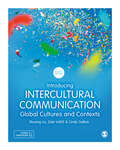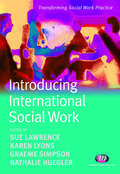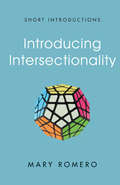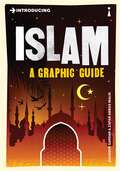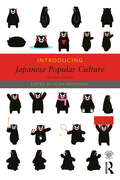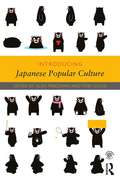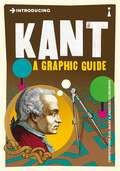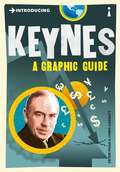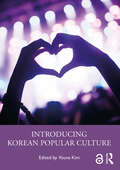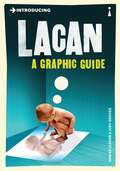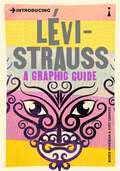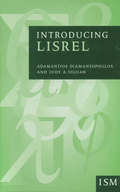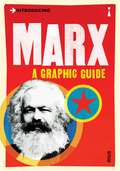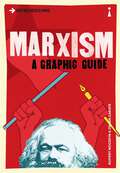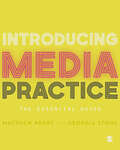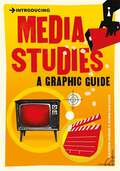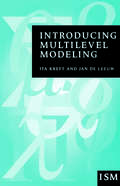- Table View
- List View
Introducing Intercultural Communication: Global Cultures and Contexts
by Shuang Liu Zala Volcic Cindy GalloisTaking a global and critical perspective, this textbook presents the concepts, theories and applications from the field of intercultural communication in a lively and easy-to-follow style. Covering all the essential topics, from immigration and intercultural conflict, to intercultural health communication and communication in the workplace, this cutting-edge 4th edition: Explains the key theories and concepts you need to know. Brings theory to life with a range of global case studies. Ties key ideas and debates to the reality of intercultural skills and practice. Adds a new chapter on intercultural communication and business. Expands coverage of topical areas such as health and crisis communication and virtual communication in the workplace. Introducing Intercultural Communication is the ideal guide to becoming a critical consumer of information and an effective global citizen. It is essential reading for students of intercultural communication across media and communication studies, and international business and management.
Introducing International Social Work (Transforming Social Work Practice Series)
by Sue Lawrence Karen H. Lyons Graeme Simpson Nathalie HueglerThis book guides the reader through the international development of social work and discusses how aspects of globalisation are making it an increasingly international activity and profession. Individual chapters locate the UK population historically and currently as a multicultural community and explore the international issues that social workers in the UK confront in their daily practice with children and families, people with mental health issues and older people. This text helps students meet the academic benchmarks and National Occupational Standards that require them to locate social work practice in a European and international context.
Introducing International Social Work (Transforming Social Work Practice Series)
by Sue Lawrence, Karen Lyons, Graeme Simpson and Nathalie HueglerThis book guides the reader through the international development of social work and discusses how aspects of globalisation are making it an increasingly international activity and profession. Individual chapters locate the UK population historically and currently as a multicultural community and explore the international issues that social workers in the UK confront in their daily practice with children and families, people with mental health issues and older people. This text helps students meet the academic benchmarks and National Occupational Standards that require them to locate social work practice in a European and international context.
Introducing Intersectionality (Short Introductions)
by Mary RomeroHow can we hope to understand social inequality without considering race, class, and gender in tandem? How do they interact with other categories such as sexuality, citizenship, and ableism? How does an inclusive analysis of domination and privilege move us closer to solutions touching the lives of diverse populations? In this clearly written book, Mary Romero presents intersectionality as a core facet of the sociological imagination. One-dimensional approaches are no longer acceptable. Instead, we must examine all systems of oppression simultaneously and how they integrate and work with or against each other to shape life experiences. Recognizing the dynamics of patriarchy, capitalism, and white supremacy, Romero shows how social inequality is maintained or minimized in various social settings and everyday sites of interaction. Drawing the theoretical threads together, the book demonstrates intersectional approaches in action in relation to the care crisis and wealth divide, to highlight the different understandings of these issues and their solutions arising from a comprehensive, intersectional examination. Offering an overview of scholarly and activist tradition in the development of intersectionality and how to apply intersectionality as a lens to enrich our understandings of social life, this introductory text will be an invaluable and welcome resource for all students of sociology.
Introducing Islam: A Graphic Guide (Introducing...)
by Ziauddin SardarIslam is one of the world's great monotheistic religions. Islamic culture, spanning 1,500 years, has produced some of the finest achievements of humanity. Yet the religion followed by a fifth of humankind is too often seen in the West in terms of fundamentalism, bigotry and violence- a perception that couldn't be more wrong. Introducing Islam recounts the history of Islam from the birth of Prophet Muhammad in the 6th century to its status as a global culture and political force today. Charting the achievements of Muslim civilisation, it explains the nature and message of the Qur'an, outlines the basic features of Islamic law, and assesses the impact of colonialism on Muslim societies. Ziauddin Sardar and Zafar Abbas Malik show how Muslims everywhere are trying to live their faith and are shaping new Islamic ideas and ideals for a globalised world.
Introducing Japanese Popular Culture
by Alisa FreedmanSpecifically designed for use in a range of undergraduate and graduate courses, while reaching specialists and general readers, this second edition of Introducing Japanese Popular Culture is a comprehensive textbook offering an up-to-date overview of a wide variety of media forms. It uses particular case studies as a way into examining the broader themes in Japanese culture and provides a thorough analysis of the historical and contemporary trends that have shaped artistic production, as well as politics, society, and economics. As a result, more than being a time capsule of influential trends, this book teaches enduring lessons about how popular culture reflects the societies that produce and consume it. With contributions from an international team of scholars, representing a range of disciplines from history and anthropology to art history and media studies, the book covers: Characters Television Videogames Fan media and technology Music Popular cinema Anime Manga Spectacles and competitions Sites of popular culture Fashion Contemporary art. Written in an accessible style with ample description and analysis, this textbook is essential reading for students of Japanese culture and society, Asian media and popular culture, globalization, and Asian Studies in general. It is a go-to handbook for interested readers and a compendium for scholars.
Introducing Japanese Popular Culture
by Alisa Freedman Toby SladeSpecifically designed for use on a range of undergraduate and graduate courses, Introducing Japanese Popular Culture is a comprehensive textbook offering an up-to-date overview of a wide variety of media forms. It uses particular case studies as a way into examining the broader themes in Japanese culture and provides a thorough analysis of the historical and contemporary trends that have shaped artistic production, as well as, politics, society, and economics. As a result, more than being a time capsule of influential trends, this book teaches enduring lessons about how popular culture reflects the societies that produce and consume it. With contributions from an international team of scholars, representing a range of disciplines from history and anthropology to art history and media studies, the book’s sections include: Television Videogames Music Popular Cinema Anime Manga Popular Literature Fashion Contemporary Art Written in an accessible style by a stellar line-up of international contributors, this textbook will be essential reading for students of Japanese culture and society, Asian media and popular culture, and Asian Studies in general.
Introducing Japanese Popular Culture
by Alisa Freedman Toby SladeSpecifically designed for use on a range of undergraduate and graduate courses, Introducing Japanese Popular Culture is a comprehensive textbook offering an up-to-date overview of a wide variety of media forms. It uses particular case studies as a way into examining the broader themes in Japanese culture and provides a thorough analysis of the historical and contemporary trends that have shaped artistic production, as well as, politics, society, and economics. As a result, more than being a time capsule of influential trends, this book teaches enduring lessons about how popular culture reflects the societies that produce and consume it. With contributions from an international team of scholars, representing a range of disciplines from history and anthropology to art history and media studies, the book’s sections include: Television Videogames Music Popular Cinema Anime Manga Popular Literature Fashion Contemporary Art Written in an accessible style by a stellar line-up of international contributors, this textbook will be essential reading for students of Japanese culture and society, Asian media and popular culture, and Asian Studies in general.
Introducing Japanese Popular Culture
Specifically designed for use in a range of undergraduate and graduate courses, while reaching specialists and general readers, this second edition of Introducing Japanese Popular Culture is a comprehensive textbook offering an up-to-date overview of a wide variety of media forms. It uses particular case studies as a way into examining the broader themes in Japanese culture and provides a thorough analysis of the historical and contemporary trends that have shaped artistic production, as well as politics, society, and economics. As a result, more than being a time capsule of influential trends, this book teaches enduring lessons about how popular culture reflects the societies that produce and consume it. With contributions from an international team of scholars, representing a range of disciplines from history and anthropology to art history and media studies, the book covers: Characters Television Videogames Fan media and technology Music Popular cinema Anime Manga Spectacles and competitions Sites of popular culture Fashion Contemporary art. Written in an accessible style with ample description and analysis, this textbook is essential reading for students of Japanese culture and society, Asian media and popular culture, globalization, and Asian Studies in general. It is a go-to handbook for interested readers and a compendium for scholars.
Introducing Kant: A Graphic Guide (Introducing...)
by Christopher Kul-WantIllustrated INTRODUCING guide to the pre-eminent philosopher of the Enlightenment. Immanuel Kant laid the foundations of modern Western thought. Every subsequent major philosopher owes a profound debt to Kant?s attempts to delimit human reason as an appropriate object of philosophical enquiry. And yet, Kant's relentless systematic formalism made him a controversial figure in the history of the philosophy that he helped to shape. Introducing Kant focuses on the three critiques of Pure Reason, Practical Reason and Judgement. It describes Kant's main formal concepts: the relation of mind to sensory experience, the question of freedom and the law and, above all, the revaluation of metaphysics. Kant emerges as a diehard rationalist yet also a Romantic, deeply committed to the power of the sublime to transform experience. The book explores the paradoxical nature of his ideas and explains the reasons for his undiminished importance in contemporary philosophical debates.
Introducing Keynes: A Graphic Guide (Introducing... Ser.)
by Peter PughAs we find ourselves at the cusp of an economic downturn, there has been a clear reinvigoration of Keynesian economics as governments are attempting to stimulate the market through public funds. Forming his economic theories in the wake of the Great Depression, John Maynard Keynes argued that a healthy economy depended on the total spending of consumers, business investors and, most importantly, governments too. Keynes formulated that governments should take control of the economy in the short term, rather than relying on the market, because, as he eloquently put it 'in the long run, we are all dead'. This graphic guide is the ideal introduction to one of the most influential economists of the 20th century, at a time when his theories may be crucial to our economic survival. Through a deft mixture of words and images, "Introducing Keynes" is a timely, accessible and enjoyable read.
Introducing Korean Popular Culture
by Youna KimThis new textbook is a timely and interdisciplinary resource for students looking for an introduction to Korean popular culture, exploring the multifaceted meaning of Korean popular culture at micro and macro levels and the process of cultural production, representation, circulation and consumption in a global context. Drawing on perspectives from the humanities and social sciences, including media and communications, film studies, musicology, cultural studies, sociology, anthropology, history and literature, this book provides a comprehensive and up-to-date overview of Korean popular culture and its historical underpinnings, changing roles and dynamic meanings in the present moment of the digital social media age. The book’s sections include: K-pop Music Popular Cinema Television Web Drama, Webtoon and Animation Digital Games and Esports Lifestyle Media, Fashion and Food Nation Branding An accessible, comprehensive and thought-provoking work, providing historical and contemporary contexts, key issues and debates, this textbook will appeal to students of and providers of courses on popular culture, media studies and Korean culture and society more broadly.
Introducing Korean Popular Culture
by Youna KimThis new textbook is a timely and interdisciplinary resource for students looking for an introduction to Korean popular culture, exploring the multifaceted meaning of Korean popular culture at micro and macro levels and the process of cultural production, representation, circulation and consumption in a global context. Drawing on perspectives from the humanities and social sciences, including media and communications, film studies, musicology, cultural studies, sociology, anthropology, history and literature, this book provides a comprehensive and up-to-date overview of Korean popular culture and its historical underpinnings, changing roles and dynamic meanings in the present moment of the digital social media age. The book’s sections include: K-pop Music Popular Cinema Television Web Drama, Webtoon and Animation Digital Games and Esports Lifestyle Media, Fashion and Food Nation Branding An accessible, comprehensive and thought-provoking work, providing historical and contemporary contexts, key issues and debates, this textbook will appeal to students of and providers of courses on popular culture, media studies and Korean culture and society more broadly.
Introducing Lacan: A Graphic Guide (Introducing...)
by Darian LeaderJacques Lacan is now regarded as a major psychoanalytical theorist alongside Freud and Jung, although recognition has been delayed by fierce arguments over his ideas. Written by a leading Lacanian analyst, "Introducing Lacan" guides the reader through his innovations, including his work on paranoia, his addition of structural linguistics to Freudianism and his ideas on the infant 'mirror phase'. It also traces Lacan's influence in postmodern critical thinking on art, literature, philosophy and feminism. This is the ideal introduction for anyone intrigued by Lacan's ideas but discouraged by the complexity of his writings.
Introducing Levi-Strauss: A Graphic Guide (Introducing...)
by Boris Wiseman Judy GrovesIntroducing Lévi-Strauss is a guide to the work of the great French anthropologist Claude Lévi-Strauss (1908–2009). The book brilliantly traces the development and influence of Lévi-Strauss' thought, from his early work on the function of the incest taboo to initiate an exchange of women between groups, to his identification of a timeless “wild” or “primitive” mode of thinking – a pensée sauvage – behind the processes of human culture. Accessibly written by Boris Wiseman and beautifully illustrated by Judy Groves, Introducing Lévi-Strauss also explores the major contribution that Lévi-Strauss made to contemporary aesthetic history – his work on American-Indian mythology provides a key insight into the way in which art itself comes into being. This is an essential introduction to a key thinker.
Introducing LISREL: A Guide for the Uninitiated (Introducing Statistical Methods series)
by Judy A Siguaw Adamantios Diamantopoulos`If you encounter a research student for whom the very word LISREL induces feelings of fear, quietly recommend that they read this book. They will thank you for it. With increasingly user-friendly versions of LISREL being released and guide books such as this published, LISREL really should be accessible to all′ - European Journal of Marketing Emphasizing substantive issues rather than intricate statistical details, this book provides a comprehensive introduction to LISREL for structural equation modeling (SEM) using a non-technical, user-oriented approach that. The emphasis is on: - exposing the reader to the major steps associated with the formulation and testing of a model under the LISREL framework - describing the key decisions associated with each step - highlighting potential problems and limitations associated with LISREL modeling - assisting the interpretation of LISREL input and output files. The overall aim is to provide a critical understanding of what is really involved in LISREL modeling and sensitize the reader against `mechanically′ fitting or modifying models. The entire range of decisions associated with the practical application of the LISREL program is covered in a user-friendly fashion. Concrete examples are used throughout to illustrate issues relating to model conceptualization, specification, identification, estimation, evaluation, modification, and cross-validation and illustrated with actual program output. The program is made much more accessible by adopting the more user-friendly SIMPLIS command language for preparing input files. Although primarily aimed at beginning users, readers are directed to further reading together with a comprehensive bibliography for the more advanced user.
Introducing LISREL: A Guide for the Uninitiated (Introducing Statistical Methods series)
by Judy A Siguaw Adamantios Diamantopoulos`If you encounter a research student for whom the very word LISREL induces feelings of fear, quietly recommend that they read this book. They will thank you for it. With increasingly user-friendly versions of LISREL being released and guide books such as this published, LISREL really should be accessible to all′ - European Journal of Marketing Emphasizing substantive issues rather than intricate statistical details, this book provides a comprehensive introduction to LISREL for structural equation modeling (SEM) using a non-technical, user-oriented approach that. The emphasis is on: - exposing the reader to the major steps associated with the formulation and testing of a model under the LISREL framework - describing the key decisions associated with each step - highlighting potential problems and limitations associated with LISREL modeling - assisting the interpretation of LISREL input and output files. The overall aim is to provide a critical understanding of what is really involved in LISREL modeling and sensitize the reader against `mechanically′ fitting or modifying models. The entire range of decisions associated with the practical application of the LISREL program is covered in a user-friendly fashion. Concrete examples are used throughout to illustrate issues relating to model conceptualization, specification, identification, estimation, evaluation, modification, and cross-validation and illustrated with actual program output. The program is made much more accessible by adopting the more user-friendly SIMPLIS command language for preparing input files. Although primarily aimed at beginning users, readers are directed to further reading together with a comprehensive bibliography for the more advanced user.
Introducing Marx: A Graphic Guide (Introducing...)
by RiusCompact INTRODUCING guide to the influential philosopher, sociologist and economist. INTRODUCING MARX - A GRAPHIC GUIDE explores the life of the most famous Socialist figure, from his early years to meeting Engels in1842. It provides a readable, understandable biography of Karl Marx as well as a fundamental account of his original philosophy, its roots in 19th century European ideology, his radical economic and social criticism of capitalism that inspired vast 20th century revolutions.
Introducing Marxism: A Graphic Guide (Introducing... #0)
by Rupert WoodfinWas Marx himself a 'Marxist'? Was his visionary promise of socialism betrayed by Marxist dictatorship? Is Marxism inevitably totalitarian? What did Marx really say? "Introducing Marxism" provides a fundamental account of Karl Marx's original philosophy, its roots in 19th century European ideology, his radical economic and social criticism of capitalism that inspired vast 20th century revolutions. It assesses Marxism's Russian disciples, Lenin, Trotsky and Stalin who forged a ruthless dogmatic Communism. The book examines the alternative Marxist approaches of Gramsci, the Frankfurt School of critical theory and the structuralist Marxism of Althusser in the 1960s. It marshals postmodern interpretations of Marxism and raises the spectre of 'post-Marxism' in Derrida's confrontation with Fukuyama's 'end of history' doctrine.
Introducing Media Practice: The Essential Guide
by Matthew Kerry Georgia StoneTaking readers from media students to media professionals, Introducing Media Practice brings together the 'why' and the 'how to' of media studies. It explains how adding theory to practice improves students' media projects, and shows them how to develop the kind of project skills they need for a career in the creative and media industries. With a clear, easy-to-follow structure, the book: Covers the full range of media practice skills, from building production teams and writing briefs, through audience research and scripting, to production, distribution and evaluation. Offers a range of exercises for both the classroom and independent learning, helping students put their learning into practice, build their confidence and establish a portfolio. Includes a glossary of key terms, helping students to get to grips with the concepts they need to know to succeed. By bridging the gap between theory and practice, this book provides students with a richer understanding of both. It is the ideal guide to succeeding in a media degree, enhancing their employability, and preparing for a career in the creative and media industries.
Introducing Media Practice: The Essential Guide
by Matthew Kerry Georgia StoneTaking readers from media students to media professionals, Introducing Media Practice brings together the 'why' and the 'how to' of media studies. It explains how adding theory to practice improves students' media projects, and shows them how to develop the kind of project skills they need for a career in the creative and media industries. With a clear, easy-to-follow structure, the book: Covers the full range of media practice skills, from building production teams and writing briefs, through audience research and scripting, to production, distribution and evaluation. Offers a range of exercises for both the classroom and independent learning, helping students put their learning into practice, build their confidence and establish a portfolio. Includes a glossary of key terms, helping students to get to grips with the concepts they need to know to succeed. By bridging the gap between theory and practice, this book provides students with a richer understanding of both. It is the ideal guide to succeeding in a media degree, enhancing their employability, and preparing for a career in the creative and media industries.
Introducing Media Studies: A Graphic Guide (Introducing...)
by Ziauddin SardarThe media is ubiquitous. Every day we watch hours of TV, listen to the radio, read newspapers and magazines, go to the cinema, sit in front of videos or surf the Web. These information commodities exercise enormous influence and power over all of us. Introducing Media Studies explores the complex relationship between the media, ideology, knowledge and power. It provides a scintillating tour of media history and presents a coherent view of the media industry, media theory and methods in media research. It explains how 'the audience' is constructed and how it in turn interprets the content and meaning of media representation. We also learn how to analyse film, deconstruct advertising and appreciate how TV and the press shape public opinion. The media is a condition of our existence and, in an unprecedented way, the pervading shape of our history. No one can afford to neglect a critical understanding of its omnipresence. Here is an entertaining and informative book, accessible to students and general readers concerned with the increasing power, influence and proliferation of the media.
Introducing Multilevel Modeling
by Ita G Kreft Jan De LeeuwThis is the first accessible and practical guide to using multilevel models in social research. Multilevel approaches are becoming increasingly important in social, behavioural, and educational research and it is clear from recent developments that such models are seen as being more realistic, and potentially more revealing, than ordinary regression models. While other books describe these multilevel models in considerable detail none focuses on the practical issues and potential problems of doing multilevel analyses that are covered in Introducing Multilevel Modeling. The authors' approach is user-oriented and the formal mathematics and statistics are kept to a minimum. Other key features include the use of worked examples using real data sets, analyzed using the leading computer package for multilevel modeling - MLn. Discussion site at: http:\\www.stat.ucla.edu\phplib\w-agora\w-agora.phtml?bn=Sagebook Data files mentioned in the book are available from: http:\\www.stat.ucla.edu\~deleeuw\sagebook
Introducing Peace Museums (Routledge Research in Museum Studies)
by Joyce ApselNominated for the 2017 Dayton Literary Peace Prize in non-fiction This volume examines peace museums, a small and important (but often overlooked) series of museums whose numbers have multiplied world-wide in recent decades. They relate stories and display artifacts—banners, diaries, and posters for example about such themes as: art and peace, antiwar histories, protest, peacekeeping and social justice and promote cultures of peace. This book introduces their different approaches from Japan, which has the largest number of sites, to Bradford, UK and Guernica, Spain. Some peace museums and centers emphasize popular peace symbols and figures, others provide alternative narratives about conscientious objection or civil disobedience, and still others are sites of persuasion, challenging the status quo about issues of war, peace, disarmament, and related issues.Introducing Peace Museums distinguishes between different types of museums that are linked to peace in name, theme or purpose and discusses the debates which surround peace museums versus museums for peace. This book is the first of its kind to critically evaluate the exhibits and activities of this group of museums, and to consider the need for a "critical peace museum studies" which analyses their varied emphasis and content. The work of an experienced specialist, this welcome introduction to peace museums considers the challenges and opportunities faced by these institutions now and in the future.
Introducing Peace Museums (Routledge Research in Museum Studies)
by Joyce ApselNominated for the 2017 Dayton Literary Peace Prize in non-fiction This volume examines peace museums, a small and important (but often overlooked) series of museums whose numbers have multiplied world-wide in recent decades. They relate stories and display artifacts—banners, diaries, and posters for example about such themes as: art and peace, antiwar histories, protest, peacekeeping and social justice and promote cultures of peace. This book introduces their different approaches from Japan, which has the largest number of sites, to Bradford, UK and Guernica, Spain. Some peace museums and centers emphasize popular peace symbols and figures, others provide alternative narratives about conscientious objection or civil disobedience, and still others are sites of persuasion, challenging the status quo about issues of war, peace, disarmament, and related issues.Introducing Peace Museums distinguishes between different types of museums that are linked to peace in name, theme or purpose and discusses the debates which surround peace museums versus museums for peace. This book is the first of its kind to critically evaluate the exhibits and activities of this group of museums, and to consider the need for a "critical peace museum studies" which analyses their varied emphasis and content. The work of an experienced specialist, this welcome introduction to peace museums considers the challenges and opportunities faced by these institutions now and in the future.
